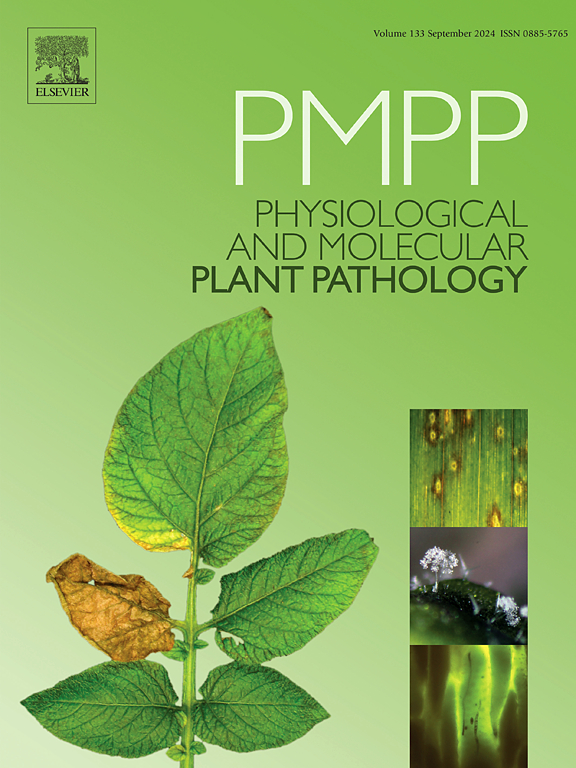Identification and expression analysis of ZF-HD transcription factor family and their expression profiles under abiotic and biotic stresses in mango (Mangifera indica)
IF 2.8
3区 农林科学
Q2 PLANT SCIENCES
引用次数: 0
Abstract
To explore the sequence and expression characteristics of the ZF-HD (zinc finger homeodomain) family in mango (Mangifera indica), sequence analysis of the ZF-HD family was performed using bioinformatics, and RT-qPCR was used to study the transcription levels of the ZF-HD genes during abiotic and biotic stresses. The results showed that 17 members of ZF-HD genes were identified in the mango genome, and a phylogenetic tree was constructed with 59 members of the ZF-HD transcription factor from Arabidopsis, poplar (Populus euphratica), and rice (Oryza sativa), and divided into five evolutionary branches. Moreover, the MiZHDs were unevenly distributed into four groups, including MIF (MiZHD1, MiZHD11, MiZHD7, MiZHD13), ZHDⅠ (MiZHD3, MiZHD10, MiZHD14), ZHDⅢ (MiZHD4, MiZHD5, MiZHD9, MiZHD16, MiZHD17), and ZHDⅣ (MiZHD8, MiZHD2, MiZHD6, MiZHD12, MiZHD15). Interestingly, MIF subfamily members have only one structural domain, and other ZHD subfamilies have two domains. RT-qPCR analysis showed that the relative expression of MiZHD4, MiZHD5, MiZHD6, MiZHD9, MiZHD11, MiZHD13, MiZHD14, MiZHD15, and MiZHD16 was significantly up-regulated at 3 h in response to salt stress. Under drought stress, the relative transcription level of MiZHDs was significantly up-regulated at 6 h, except MiZHD12, MiZHD13, MiZHD15, and MiZHD17. During Xanthomonas campestris pv. mangiferaeindicae infection, the expression of MiZHD1 and MiZHD11 were significantly induced at 24, 48, and 72 h post infection (hpi). However, most genes were down-regulated during Colletotrichum gloeosporioides infection, only MiZHD16 was significantly up-regulated during 3–48 hpi. In addition, expression analysis revealed that MiZHD7 and MiZHD8 responsed to salicylic acid treatment. These results broadened our understanding of the biological functions and molecular mechanisms of ZF-HD genes, which will provide a theoretical basis for the functional study of the ZF-HD gene family in mango.
芒果ZF-HD转录因子家族的鉴定、表达分析及其在非生物和生物胁迫下的表达谱
为探索芒果ZF-HD(锌指同源结构域)家族的序列和表达特征,采用生物信息学方法对芒果ZF-HD家族进行了序列分析,并采用RT-qPCR方法研究了ZF-HD基因在非生物胁迫和生物胁迫下的转录水平。结果表明,在芒果基因组中鉴定出17个ZF-HD基因,并构建了来自拟南芥、杨树(Populus euphratica)和水稻(Oryza sativa)的59个ZF-HD转录因子的系统发育树,并将其划分为5个进化分支。此外,mizhd不均匀分布为4组,包括MIF (MiZHD1、MiZHD11、MiZHD7、MiZHD13)、ZHDⅠ(MiZHD3、MiZHD10、MiZHD14)、ZHDⅢ(MiZHD4、MiZHD5、MiZHD9、MiZHD16、MiZHD17)和ZHDⅣ(MiZHD8、MiZHD2、MiZHD6、MiZHD12、MiZHD15)。有趣的是,MIF亚家族成员只有一个结构域,而其他ZHD亚家族有两个结构域。RT-qPCR分析显示,在盐胁迫下,MiZHD4、MiZHD5、MiZHD6、MiZHD9、MiZHD11、MiZHD13、MiZHD14、MiZHD15和MiZHD16的相对表达量在3 h时显著上调。干旱胁迫下,除MiZHD12、MiZHD13、MiZHD15和MiZHD17外,其余4个基因的相对转录水平在6 h时均显著上调。油菜黄单胞菌pv。mangiferaeindicae感染后,在感染后24、48和72 h (hpi)显著诱导MiZHD1和MiZHD11的表达。3 ~ 48 hpi时,大部分基因表达下调,只有MiZHD16基因表达显著上调。此外,表达分析显示,MiZHD7和MiZHD8对水杨酸处理有反应。这些结果拓宽了我们对ZF-HD基因的生物学功能和分子机制的认识,将为芒果ZF-HD基因家族的功能研究提供理论依据。
本文章由计算机程序翻译,如有差异,请以英文原文为准。
求助全文
约1分钟内获得全文
求助全文
来源期刊
CiteScore
4.30
自引率
7.40%
发文量
130
审稿时长
38 days
期刊介绍:
Physiological and Molecular Plant Pathology provides an International forum for original research papers, reviews, and commentaries on all aspects of the molecular biology, biochemistry, physiology, histology and cytology, genetics and evolution of plant-microbe interactions.
Papers on all kinds of infective pathogen, including viruses, prokaryotes, fungi, and nematodes, as well as mutualistic organisms such as Rhizobium and mycorrhyzal fungi, are acceptable as long as they have a bearing on the interaction between pathogen and plant.

 求助内容:
求助内容: 应助结果提醒方式:
应助结果提醒方式:


